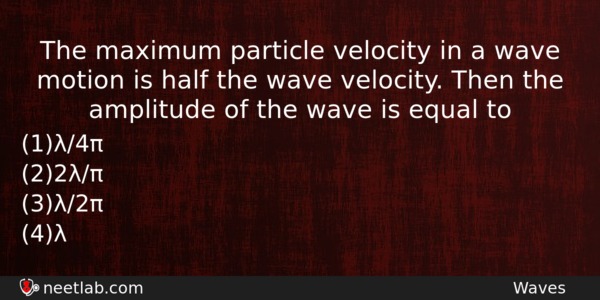| ⇦ | 
| ⇨ |
The maximum particle velocity in a wave motion is half the wave velocity. Then the amplitude of the wave is equal to
Options
(a) λ/4π
(b) 2λ/π
(c) λ/2π
(d) λ
Correct Answer:
λ/4π
Explanation:
For a wave, y = a sin [(2πvt/λ) – (2πx/λ)]
Here v = velocity of wave
.·. y = a sin [(2πvt/λ) – (2πx/λ)]
dy/dt = a (2πv/λ) cos [(2πvt/λ) – (2πx/λ)]
velocity = (2πav/λ) cos [(2πvt/λ) – (2πx/λ)]
Maximum velocity is obtained when
cos [(2πvt/λ) – (2πx/λ)] = 1
.·. v = (2πav/λ)
Then, v = v/2
(2πav/λ) = v/2 or a = λ/4π.
Related Questions: - A p-n-p transistor is used in common emitter mode in an amplifier circuit.
- A circular disc X of radius R is made from an iron plate of thickness t and another disc
- Photoelectric current from a given photocell will depend upon
- If two electric bulbs have 40 W and 60 W ratings at 220 V, then the ratio
- A liquid boils when its vapour pressure equals
Topics: Waves
(80)
Subject: Physics
(2479)
Important MCQs Based on Medical Entrance Examinations To Improve Your NEET Score
- A p-n-p transistor is used in common emitter mode in an amplifier circuit.
- A circular disc X of radius R is made from an iron plate of thickness t and another disc
- Photoelectric current from a given photocell will depend upon
- If two electric bulbs have 40 W and 60 W ratings at 220 V, then the ratio
- A liquid boils when its vapour pressure equals
Topics: Waves (80)
Subject: Physics (2479)
Important MCQs Based on Medical Entrance Examinations To Improve Your NEET Score
18000+ students are using NEETLab to improve their score. What about you?
Solve Previous Year MCQs, Mock Tests, Topicwise Practice Tests, Identify Weak Topics, Formula Flash cards and much more is available in NEETLab Android App to improve your NEET score.
Share this page with your friends

Since max. Particle velocity= aω
Wave velocity = ω/k
Acc to que
aω = 1/2 (ω/k)
Solving ,
a = 1/2k
Since k= 2π/ λ
Hence a = λ/4π